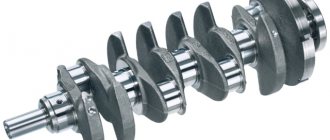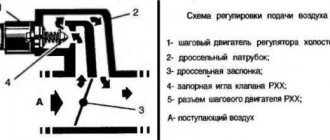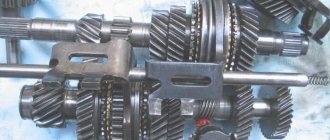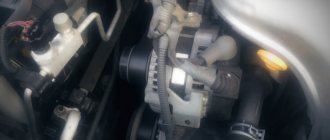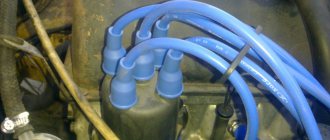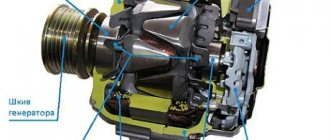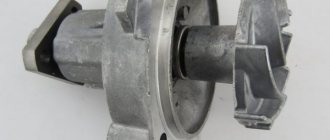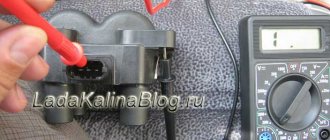Konichiwa and nihao everyone! I didn’t want to talk about politics, but in April new excise taxes on gasoline are being introduced and all analysts are predicting a possible
rising gasoline prices. At 2-2.5 rubles per liter. And not only for him, for everything in the end, the price of gasoline lies in all goods... What should men do in this case? That's right, armed with knowledge, start checking all the systems of your favorite car so that you eat less and drive more! So I became concerned and checked what we have with the DBP sensor, also known as MAP sensor, also known as the absolute pressure sensor in the intake manifold. There is an opinion that he is degrading and starting to lie, then he needs to be changed. The purpose of the test was to fix the extreme points for analyzing its characteristics. At the same time, we managed to reproduce a malfunction characteristic of Avelka, in which at idle the speed drops and jumps rhythmically from 200...300 to 1500...2000, the stink of gasoline from the plug is stinking and the car drives as it wants.
Let's start with the video. As always, I remind you that when you get into the machine’s systems, you act at your own peril and risk! Always make sure there are no short circuits in the connections. We connect to the middle contact by inserting a pin along the wire all the way into the contact and hanging the probe from it. I took the minus from the battery.
If you accurately measure the vacuum at idle and the corresponding output voltage, and then the same values at atmospheric pressure and build a graph based on these two points, then by superimposing it on the factory one, built according to the table, the vacuum/voltage in the specifications for the sensor can be seen in the tolerance whether he.
So why does the speed increase when there is a hole in the vacuum hose of the sensor or some leak in the manifold? Further everything is imho. The sensor thinks that the valve has opened and the pressure has dropped, but there is no vacuum. The ECU obediently pours gasoline, first increasing the speed, and then the oxygen in the manifold runs out, the valve is closed, but does not flow through the hole in the required volumes. And the engine stops. And when the engine sags, the ECU understands that something needs to be done and opens the xx valve, a portion of oxygen arrives, the speed increases, the engine accelerates and burns it out, the speed drops, and so on again. It is enough to open the throttle and the build-up goes away. This is exactly what I did immediately after starting - I screwed in the thrust screw and the engine began to rumble, albeit at high speeds, but smoothly. And then I inspected all the pipes, cleaned the throttle with the xx valve and, having eliminated all the leaks, I was able to set normal idle speed.
PS Take a look at my driving blog. Some materials on the car are now being laid out there.
Let's start with the main thing and decipher the mysterious abbreviations. So, the MAF sensor (aka Mass Air Flow sensor) is a mass air flow sensor (MAF), an important element of electronic engine control systems in cars with fuel injection. MAP sensor (Manifold Absolute Pressuresensor) is an absolute pressure sensor (DAP) located in the intake manifold of cars. Absolutely every modern car that comes off the assembly line is equipped with either one of these sensors, or MAP and MAF sensors simultaneously. Now let's move on to the details.
Read more: Ford Mondeo 3 spark plugs
Mass air flow sensor (MAF)
Mass air flow sensor function
It is part of the engine management system. It is also called an “air flow sensor” or “air mass meter”. It is installed between the air filter and the throttle valve and determines the volume of air passing through the intake system of diesel and gasoline internal combustion engines. Using information about the amount of air, the engine control unit (ECU) can determine the optimal ratio and supply the required amount of fuel to the engine.
Currently, most MAF sensors come in two versions: heated filament or heated film.
The principle of operation of a mass air flow sensor with a heated filament
The heated filament MAF sensor has a sensing element that is heated electrically to a temperature 75°C to 100°C above the intake air temperature. As the air flow passes through the measuring element, it cools the element and increases the current required to maintain the high temperature of the element. The amount of current required to maintain a high temperature is proportional to the amount of air entering the engine.
Operating principle of mass air flow sensor with heated film (option I)
The heated film MAF sensor operates in a similar way to heated filament technology. The heating element in the form of a thin film is heated to a certain temperature relative to the inlet air temperature. When there is no air flow, heat dissipation occurs due to the thermal conductivity of the air. When air moves, heat transfer increases linearly with air flow. Based on the current required for heating, the electronics are able to calculate the mass of air.
Operating principle of mass air flow sensor with heated film (option II)
The heated film version of the MAF sensor has 2 measuring elements with a heated ceramic element between them. When the engine is not running and there is no air flow, heat is distributed evenly in the two sensors. Both sensors produce the same air temperature. When the engine is running, the intake air flows from T1 towards T2 through the sensing element, the air cools the T1 sensor. The air is heated above the heating element, so sensor T2 is cooled less than T1. Based on the temperature difference between sensors T1 and T2, the electronics are able to calculate the air mass.
To reduce measurement errors caused by air fluctuations in the intake manifold, some MAF sensors have a backflow detection feature that allows a more accurate calculation of air mass.
Based on the data received from the sensor, the engine control unit (ECU) determines the duration of opening of the fuel injectors, and accordingly calculates the required volume of fuel in order to maintain the stoichiometric ratio of fuel and air in a particular engine operating mode. The normal stoichiometric composition of the mixture (when it is neither rich nor lean) is 14.7:1. That is, 14.7 parts of air and 1 part of fuel from the total composition of the mixture are supplied to the cylinder.
In the assortment of the NGK company | NTK presents 57 mass air flow sensors with heated filament and 117 sensors with heated film. However, when a sensor with a heated film fails, it is not always necessary to replace the element assembly. In most cases, the sensitive mechanism of the sensor breaks down. One of the key advantages of purchasing components manufactured by NGK | NTK is the ability to replace the sensor individually, without having to pay extra for the part along with the housing. In NGK catalogs | NTK offers 25 plug-in sensors that provide compatibility with nearly 80 different housings.
Read more: How to pay for an order at Exist
Absolute pressure sensor (MAP)
DBP function
It is installed on the intake manifold and sends the necessary signals to the engine control unit (ECU). Based on these parameters, the ECU controls the ignition timing and adjusts engine operation.
Operating principle of DBP
The principle of operation is based on calculating the vacuum generated by the engine during the process. Driving in quiet mode, when the throttle valve is slightly open and no sudden acceleration or load on the engine is required, the engine's air consumption is extremely small, and the vacuum created inside is quite important. Under these operating conditions, the MAP sensor sends a signal to the engine control unit, which, relying on fuel maps, causes it to operate with less fuel consumption. When the engine is running at high speeds and the throttle is fully open, the vacuum drops. The engine consumes more air and requires more fuel. When the engine is running under load, the mixture is deliberately made richer and the ignition is delayed.
What is more accurate - MAP or MAF
A clear answer to this question has never been found.
• MAP sensors in combination with temperature sensors are not able to measure the actual volume of air entering the cylinders. MAF sensors measure actual mass air flow, but they have a limited operating range, which is especially important at very low or, conversely, high fuel consumption.
• The MAP sensor requires recalibration whenever changes are made to the engine. However, MAF is more capricious to environmental conditions and pollution.
Combines two types of sensors produced by NGK | NTK's key advantage is the consistently high quality of components that cannot be compromised. The sensors fully comply with the standards of modern manufacturers, and their design does not allow the slightest deviation in production processes or any simplification of mechanisms, which is often a hallmark of cheaper analogues of dubious production. Tampering with the original design may result in compatibility issues and errors in the engine control system.
Each sensor is manufactured by NGK | NTK undergoes long-term testing: temperature tests and checks for compliance with the declared resource, which is guaranteed by the manufacturer, as well as compliance with electrical parameters.
Hi all. Today on gboshnik.ru we’ll talk about the absolute gas pressure (GAP) sensor. You will learn a lot of interesting things about this device, for example, what it is needed for, how it works, the principle of its operation, as well as the main malfunctions of the MAP sensor of the LPG sensor.
MAP Sensor ( Manifold Absolute Pressure , MAP sensor, MAP sensor) is also an absolute gas pressure sensor, which is used on the 4th generation of gas equipment. This sensor is used to monitor pressure, as is clear from the name. The MAP sensor monitors absolute pressure (the level of vacuum in the intake manifold) and can be analog or digital. The data transmitted by the MAP Sensor is sent to the ECU, after which the DHW (gas-air mixture) is adjusted based on them. Absolute pressure also allows you to determine the degree of load on the power unit, as well as the opening angle of the throttle valve.
Read more: Photos of beautiful girls with cars
As you understand, the correct proportion of hot water that enters the cylinders, and therefore the overall engine performance, depends on the correct operation of the MAP sensor. Any malfunction of the DBP will lead to a violation of the proportion and the mixture will become either “rich” or “poor”. In any of these cases, the engine will not work correctly and as a result, power failures or excessive fuel consumption may occur.
MAP sensor - what is it?
MAP sensor - what is it?
Let's talk about what a MAP sensor is and how it works.
The MAP sensor (Manifold Absolute Pressure) or DBP (Absolute Pressure Sensor) is installed on the intake manifold and is a key device for sending the required signal to the engine control unit (ECU). According to the values received from the MAP, the engine control unit “knows” how to control the ignition timing and adjusts the operation of the engine, according to its fuel maps, prescribed in it by the manufacturer.
The operating principle is based on calculating the vacuum generated by the engine during operation. Let's look at a simple example.
When driving in a quiet mode, when the throttle is slightly open and no sudden acceleration or engine load is required, the engine's air consumption is extremely small, and the vacuum created inside is quite significant. Under these operating conditions, MAP sends a signal to the engine control unit, which, relying on fuel maps, causes it to operate with less fuel consumption.
Advertising (to support pants)
When the engine is running at high speeds and the throttle is fully open, the vacuum drops. The engine consumes more air and requires more fuel to keep the air/fuel ratio in the desired balance. Almost all fuel maps prescribed by the manufacturer have a protective function - to protect the engine from detonation, which is why, under loaded engine operation, the mixture is deliberately made richer and the ignition is delayed.
In other words, the MAP sensor measures the pressure inside the engine. When the engine is not running, MAP sees the barometric pressure that surrounds us. But as soon as you start the engine, it begins to measure the pressure inside itself, and when the damper is fully open, the value between the internal pressure and the external barometric pressure gradually decreases.
JEEP vehicles equipped with 2.5L, 4.0L, 5.2L injection engines are equipped with analogue MAP sensors.
The MAP sensor consists of two chambers separated by a flexible diaphragm. One chamber is “air”, which can be either sealed or connected by a valve to the external environment, and the other chamber is absolutely vacuum and is connected to the intake manifold by a tube or stands directly on the manifold.
A sensitive circuit inside the MAP sensor monitors the movement of the diaphragm and generates a signal that varies proportionally to pressure. This process produces an analog voltage signal that typically ranges from 1 to 5 volts.
Analog MAP sensors typically have three pins in the connector: ground, a 5-volt reference signal from the ECU, and a return signal. The output voltage typically increases when the throttle is open and the vacuum inside the engine drops. Now that we understand the basic principle and know how the MAP sensor works, let's talk about a device that can make corrections to the operation of the engine, regardless of its load.
Advertising (to support pants)
We know that the ECU receives a signal from the MAP which generates volts. So let's trick the MAP and give it the volts we want. This may be necessary to save fuel by leaning the mixture, or to obtain greater efficiency by enriching the mixture. This device can be useful if you have upgraded the intake manifold and installed higher flow injectors, or simply want to save fuel when driving on the highway.
How to check the map sensor
Many cars have two sensors: MAP (manifold absolute pressure) and BP (barometric pressure). The first measures the pressure in the intake manifold, and the second measures the pressure in the surrounding space (they show the same pressure in space, with fairly large holes in the manifold body, not counting the throttle and valve openings, and with the engine turned off). So at least in this we (Fordists and Fordists) are lucky - we have one MAP sensor, which is actually MAP/BP. And it performs both functions, but in turn. While the engine has not yet been started, BP (not to be confused with the oil company of the same name) and EEC “remember” the atmospheric pressure. When the engine is running, it measures the pressure in the manifold and thus the EEC is aware of the vacuum on the intake manifold and, depending on this (but not only this), decides how much gasoline to add through the injectors. Hence the moral - I went to the mountains - for optimal operation of the injector, turn off the car every 500 meters of elevation change :). Do this if a cyclone/anticyclone is approaching quickly :). If you adapt well, you can tell by the engine's operation that a thunderstorm is approaching :). Most abnormal cars (cars other than Ford and GM) have MAP sensors that will output some voltage or resistance depending on the pressure. On normal machines (see above), the result is a frequency (from 90 to 160 Hz) which actually reports the EEC as we have with pressure. On Sierra (I think on other Fords) wires: brown -46 core-black -26 (on EEC) Accordingly, 5 V between 46 and 26, and at 45 the frequency is not volts (which is why the Ford MAP is different from others). According to the Internet, it should show 100-110 Hz at idle - but I don’t always trust what is written. It should be noted that there is a terrible section for diagnosing engines. The Internet is full of places where they tell how, using MAP, you can display a vacuum profile on an oscilloscope and use it to diagnose a lot of things (for example, the condition of valves in different pots, etc.). It should be noted that on Ford you must first convert the frequency to volts

